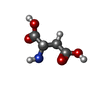[English] 日本語
 Yorodumi
Yorodumi- PDB-6wyl: Cryo-EM structure of GltPh L152C-G351C mutant in the intermediate... -
+ Open data
Open data
- Basic information
Basic information
| Entry | Database: PDB / ID: 6wyl | |||||||||||||||||||||||||||||||||
|---|---|---|---|---|---|---|---|---|---|---|---|---|---|---|---|---|---|---|---|---|---|---|---|---|---|---|---|---|---|---|---|---|---|---|
| Title | Cryo-EM structure of GltPh L152C-G351C mutant in the intermediate outward-facing state. | |||||||||||||||||||||||||||||||||
 Components Components | Glutamate transporter homolog | |||||||||||||||||||||||||||||||||
 Keywords Keywords | TRANSPORT PROTEIN / Glutamate transporter homolog Gltph | |||||||||||||||||||||||||||||||||
| Function / homology |  Function and homology information Function and homology informationL-aspartate transmembrane transport / L-aspartate transmembrane transporter activity / amino acid:sodium symporter activity / L-aspartate import across plasma membrane / chloride transmembrane transporter activity / protein homotrimerization / chloride transmembrane transport / metal ion binding / identical protein binding / plasma membrane Similarity search - Function | |||||||||||||||||||||||||||||||||
| Biological species |   Pyrococcus horikoshii (archaea) Pyrococcus horikoshii (archaea) | |||||||||||||||||||||||||||||||||
| Method | ELECTRON MICROSCOPY / single particle reconstruction / cryo EM / Resolution: 3.9 Å | |||||||||||||||||||||||||||||||||
 Authors Authors | Font, J. / Chen, I. / Sobti, M. / Stewart, A.G. / Ryan, R.M. | |||||||||||||||||||||||||||||||||
| Funding support |  Australia, 1items Australia, 1items
| |||||||||||||||||||||||||||||||||
 Citation Citation |  Journal: Nature / Year: 2021 Journal: Nature / Year: 2021Title: Glutamate transporters have a chloride channel with two hydrophobic gates. Authors: Ichia Chen / Shashank Pant / Qianyi Wu / Rosemary J Cater / Meghna Sobti / Robert J Vandenberg / Alastair G Stewart / Emad Tajkhorshid / Josep Font / Renae M Ryan /   Abstract: Glutamate is the most abundant excitatory neurotransmitter in the central nervous system, and its precise control is vital to maintain normal brain function and to prevent excitotoxicity. The removal ...Glutamate is the most abundant excitatory neurotransmitter in the central nervous system, and its precise control is vital to maintain normal brain function and to prevent excitotoxicity. The removal of extracellular glutamate is achieved by plasma-membrane-bound transporters, which couple glutamate transport to sodium, potassium and pH gradients using an elevator mechanism. Glutamate transporters also conduct chloride ions by means of a channel-like process that is thermodynamically uncoupled from transport. However, the molecular mechanisms that enable these dual-function transporters to carry out two seemingly contradictory roles are unknown. Here we report the cryo-electron microscopy structure of a glutamate transporter homologue in an open-channel state, which reveals an aqueous cavity that is formed during the glutamate transport cycle. The functional properties of this cavity, combined with molecular dynamics simulations, reveal it to be an aqueous-accessible chloride permeation pathway that is gated by two hydrophobic regions and is conserved across mammalian and archaeal glutamate transporters. Our findings provide insight into the mechanism by which glutamate transporters support their dual function, and add information that will assist in mapping the complete transport cycle shared by the solute carrier 1A transporter family. | |||||||||||||||||||||||||||||||||
| History |
|
- Structure visualization
Structure visualization
| Movie |
 Movie viewer Movie viewer |
|---|---|
| Structure viewer | Molecule:  Molmil Molmil Jmol/JSmol Jmol/JSmol |
- Downloads & links
Downloads & links
- Download
Download
| PDBx/mmCIF format |  6wyl.cif.gz 6wyl.cif.gz | 198.8 KB | Display |  PDBx/mmCIF format PDBx/mmCIF format |
|---|---|---|---|---|
| PDB format |  pdb6wyl.ent.gz pdb6wyl.ent.gz | 160.6 KB | Display |  PDB format PDB format |
| PDBx/mmJSON format |  6wyl.json.gz 6wyl.json.gz | Tree view |  PDBx/mmJSON format PDBx/mmJSON format | |
| Others |  Other downloads Other downloads |
-Validation report
| Summary document |  6wyl_validation.pdf.gz 6wyl_validation.pdf.gz | 900.6 KB | Display |  wwPDB validaton report wwPDB validaton report |
|---|---|---|---|---|
| Full document |  6wyl_full_validation.pdf.gz 6wyl_full_validation.pdf.gz | 906.2 KB | Display | |
| Data in XML |  6wyl_validation.xml.gz 6wyl_validation.xml.gz | 34.8 KB | Display | |
| Data in CIF |  6wyl_validation.cif.gz 6wyl_validation.cif.gz | 53.9 KB | Display | |
| Arichive directory |  https://data.pdbj.org/pub/pdb/validation_reports/wy/6wyl https://data.pdbj.org/pub/pdb/validation_reports/wy/6wyl ftp://data.pdbj.org/pub/pdb/validation_reports/wy/6wyl ftp://data.pdbj.org/pub/pdb/validation_reports/wy/6wyl | HTTPS FTP |
-Related structure data
| Related structure data |  21968MC  6wyjC  6wykC 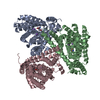 6wzbC 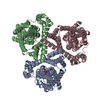 6x01C M: map data used to model this data C: citing same article ( |
|---|---|
| Similar structure data |
- Links
Links
- Assembly
Assembly
| Deposited unit | 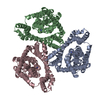
|
|---|---|
| 1 |
|
- Components
Components
| #1: Protein | Mass: 44585.035 Da / Num. of mol.: 3 / Mutation: L152C, G351C, C321S Source method: isolated from a genetically manipulated source Source: (gene. exp.)   Pyrococcus horikoshii (strain ATCC 700860 / DSM 12428 / JCM 9974 / NBRC 100139 / OT-3) (archaea) Pyrococcus horikoshii (strain ATCC 700860 / DSM 12428 / JCM 9974 / NBRC 100139 / OT-3) (archaea)Strain: ATCC 700860 / DSM 12428 / JCM 9974 / NBRC 100139 / OT-3 Gene: PH1295 / Production host:  #2: Chemical | Has ligand of interest | N | Has protein modification | N | |
|---|
-Experimental details
-Experiment
| Experiment | Method: ELECTRON MICROSCOPY |
|---|---|
| EM experiment | Aggregation state: PARTICLE / 3D reconstruction method: single particle reconstruction |
- Sample preparation
Sample preparation
| Component | Name: Glutamate transporter homolog, GltPh, in nanodisc / Type: COMPLEX / Entity ID: #1 / Source: RECOMBINANT |
|---|---|
| Source (natural) | Organism:   Pyrococcus horikoshii OT3 (archaea) Pyrococcus horikoshii OT3 (archaea) |
| Source (recombinant) | Organism:  |
| Buffer solution | pH: 7.5 |
| Specimen | Embedding applied: NO / Shadowing applied: NO / Staining applied: NO / Vitrification applied: YES |
| Specimen support | Grid material: COPPER / Grid mesh size: 200 divisions/in. / Grid type: Quantifoil R1.2/1.3 |
| Vitrification | Cryogen name: ETHANE |
- Electron microscopy imaging
Electron microscopy imaging
| Experimental equipment |  Model: Talos Arctica / Image courtesy: FEI Company |
|---|---|
| Microscopy | Model: FEI TALOS ARCTICA |
| Electron gun | Electron source:  FIELD EMISSION GUN / Accelerating voltage: 200 kV / Illumination mode: FLOOD BEAM FIELD EMISSION GUN / Accelerating voltage: 200 kV / Illumination mode: FLOOD BEAM |
| Electron lens | Mode: BRIGHT FIELD |
| Image recording | Electron dose: 40 e/Å2 / Detector mode: COUNTING / Film or detector model: FEI FALCON III (4k x 4k) |
- Processing
Processing
| Software | Name: PHENIX / Version: 1.17.1_3660: / Classification: refinement | ||||||||||||||||||||||||||||
|---|---|---|---|---|---|---|---|---|---|---|---|---|---|---|---|---|---|---|---|---|---|---|---|---|---|---|---|---|---|
| EM software |
| ||||||||||||||||||||||||||||
| CTF correction | Type: PHASE FLIPPING AND AMPLITUDE CORRECTION | ||||||||||||||||||||||||||||
| Symmetry | Point symmetry: C3 (3 fold cyclic) | ||||||||||||||||||||||||||||
| 3D reconstruction | Resolution: 3.9 Å / Resolution method: FSC 0.143 CUT-OFF / Num. of particles: 220938 / Symmetry type: POINT | ||||||||||||||||||||||||||||
| Refinement | Highest resolution: 3.9 Å | ||||||||||||||||||||||||||||
| Refine LS restraints |
|
 Movie
Movie Controller
Controller





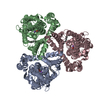
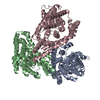
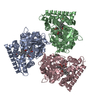
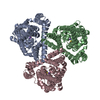
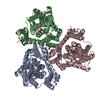
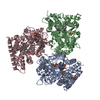
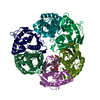
 PDBj
PDBj
